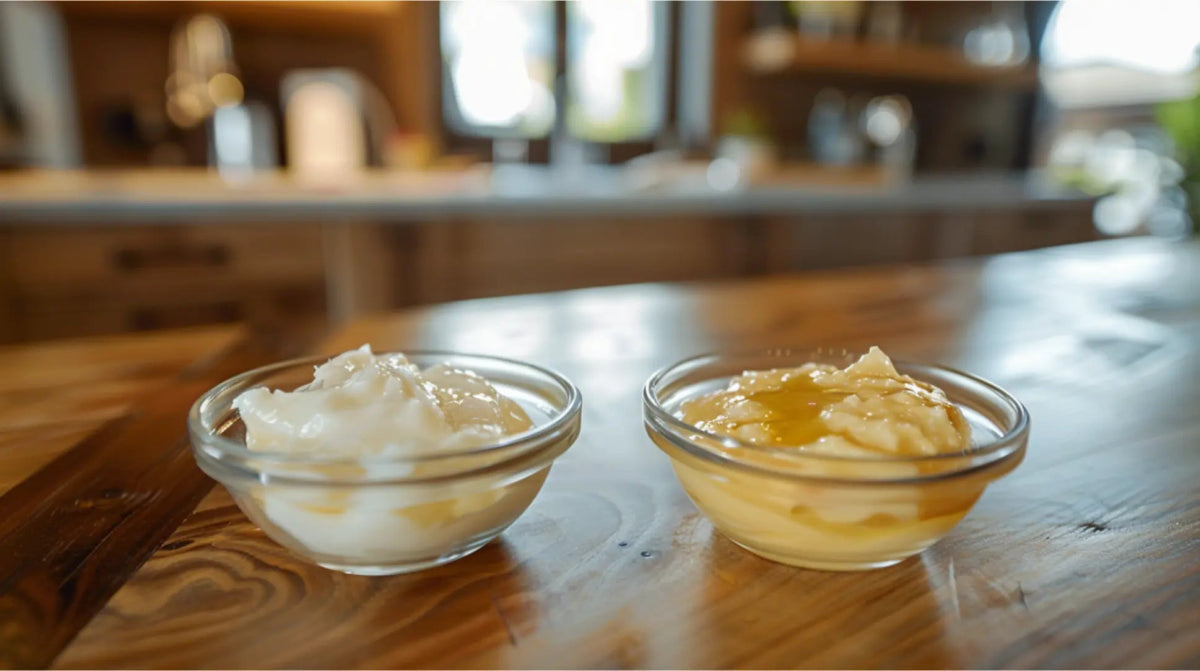
Lard or beef tallow? Your recipe calls for one, and you've got Crisco "lard" and beef tallow on hand. The quick question: is Crisco lard the same as beef tallow? The short answer: a definite no.
While both are cooking fats, their origins, what they're made from, and how they perform in your recipes are significantly different. Let's break down the key distinctions between Crisco "lard" and real beef tallow so you know exactly what you're cooking with.
What Exactly Is Crisco "Lard"? The Truth About Its Ingredients
That familiar blue tub labeled "Crisco Lard"? It might evoke images of traditional pork fat, but the reality is quite different in modern formulations.
Not Your Grandma's Lard: The Modern Manufacturing Process
Today's Crisco "lard" isn't rendered pork fat. Instead, it's primarily made through a process called hydrogenation. This involves taking vegetable oils – like soybean, cottonseed, and/or palm oil – and adding hydrogen atoms to them.
This process makes the liquid oils solid at room temperature, giving them a texture similar to traditional lard and a higher melting point.
A Blend of Oils: Understanding the Ingredient List
Take a look at the ingredient list on a container of Crisco "lard," and you'll likely see a blend of those vegetable oils mentioned above. It's important to note that it's plant-based, not animal-based.
You might also find ingredients like emulsifiers to help with texture and antioxidants to maintain freshness.
The Absence of Pork: A Key Distinction
The crucial takeaway here is that modern Crisco "lard" does not contain pork fat. This fundamental difference in origin sets it apart from both traditional lard (rendered pork fat) and, of course, beef tallow (rendered beef fat).
Read More: Beeswax for Skin: 5 Amazing Benefits & Uses
Read More: The Ultimate Guide to Best Sunscreen Ingredients for Daily Use
Beef Tallow Unveiled: The Pure Essence of Beef Fat
Now, let's talk about beef tallow. Unlike Crisco "lard," beef tallow is exactly what it sounds like: rendered fat from beef. It's a traditional fat with a rich history in cooking.
The Traditional Process of Making Tallow
Beef tallow is made by slowly heating beef fat, typically suet (the hard fat around the kidneys and loins), over a period of time. This gentle heating process separates the pure fat from any impurities and water. The result is a smooth, rendered fat that solidifies at room temperature.
Read More: Tallow as Sunscreen? Benefits & Chemical-free Use
Read More: Why Use Tallow? Nourish & Revitalize Your Skin
Understanding Its Composition
Beef tallow is primarily composed of saturated and monounsaturated fatty acids that come directly from the beef. It retains a natural flavor and aroma that is distinctly "beefy" or savory, which can impart a wonderful richness to dishes.
Sustainability and Flavor
Using beef tallow can be a sustainable practice, utilizing parts of the animal that might otherwise be discarded. Beyond that, it's prized in the culinary world for its high smoke point, making it excellent for frying, and for the deep, savory flavor it adds to everything from roasted vegetables to pastries.
Read More: Tallow Soap vs Regular Soap: Which is Better?
Key Differences That Matter for Your Skin
While both Crisco "lard" (in older formulations, potentially) and beef tallow are fats, their distinct origins and compositions lead to significant differences in how they might interact with your skin.
Plant-Based vs. Animal-Based Fatty Acids
Crisco "lard" (again, referring to older formulations where it might have been considered a skin emollient) is derived from hydrogenated vegetable oils. These are primarily long-chain fatty acids of plant origin.
Beef tallow, on the other hand, is pure rendered beef fat, rich in saturated and monounsaturated fatty acids that are structurally different from plant-based oils.
Molecular Structure and Absorption
The different types of fatty acids in Crisco (vegetable-based) and beef tallow (animal-based) can affect how well they are absorbed by the skin. Some argue that animal-derived fats have a closer resemblance to the lipids naturally found in human skin, potentially aiding in better absorption and barrier repair.
However, hydrogenated vegetable oils can also be occlusive, creating a barrier on the skin's surface.
Potential for Irritation and Sensitivity
Hydrogenated vegetable oils, depending on the specific oils and the hydrogenation process, can sometimes be irritating for sensitive skin in some individuals. Beef tallow, in its pure form, is often considered relatively gentle and well-tolerated by many, but individual reactions can still occur.
Occlusive Properties and Moisture Retention
Both types of fats can act as occlusives, meaning they create a barrier on the skin that helps to prevent moisture loss. However, the degree and specific mechanism of this occlusion might differ between hydrogenated vegetable oils and the complex lipid structure of beef tallow.
Traditional Uses in Skincare
Historically, rendered animal fats like tallow have been used in traditional skincare for their emollient and moisturizing properties. Crisco, being a more modern, industrially processed product, does not have the same historical context in skincare and was primarily developed for cooking.
Read More: Beef Tallow Moisturizer: Benefits, Uses & Guide
Read More: Best Beef Tallow Moisturizers 2025: Top Picks
Conclusion
When considering their potential impact on skin, it's clear that Crisco (primarily hydrogenated vegetable oils) and beef tallow are not the same. Their fundamental difference in origin – plant versus animal – leads to variations in their fatty acid composition, potential absorption, and historical use.
While both can act as occlusives, beef tallow, with its complex animal-derived lipids, has a longer history in traditional skincare and may offer different benefits for some individuals. Ultimately, understanding these key differences is crucial when exploring the potential of either ingredient for your skin.
Read More: Best Day & Night Moisturizer for Glowing Skin
Read More: What's Inside Sky&Sol Lip Jelly? (And Why It Matters)
Read More: The Benefits of Tallow Soap for Healthy and Glowing Skin
Read More: Best Beef Tallow Skincare Products for Radiant Skin

